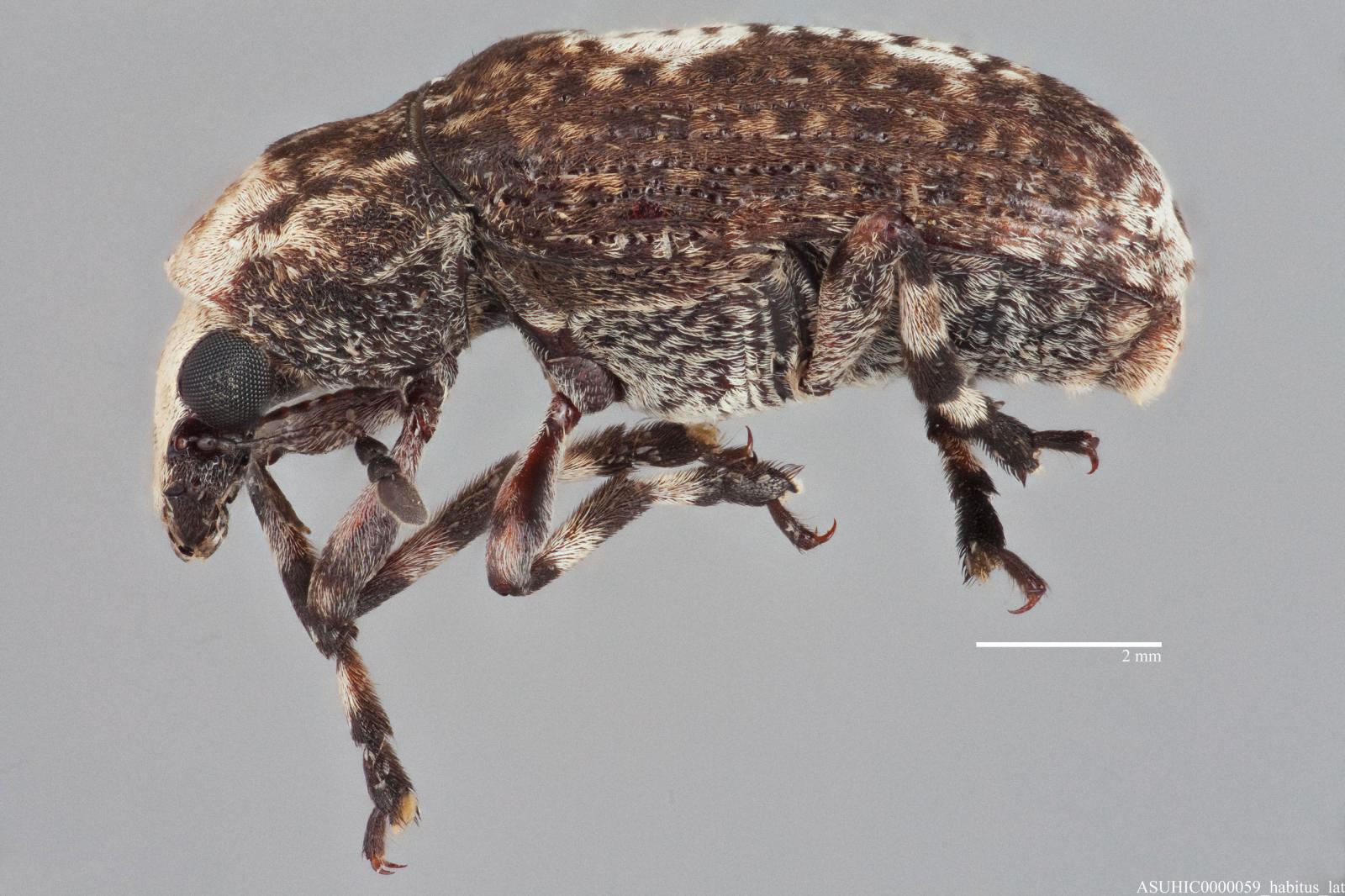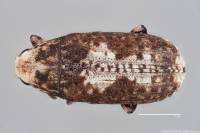Go to Encyclopedia of Life...
Source: Valentine, B.D. 1998. A review of Nearctic and some related Anthribidae (Coleoptera). Insecta Mundi 12(3&4): 215-296.
Family: Anthribidae
Holotype (variation in parentheses); length, head excluded 8.5 (7.5 to 9.0) mm. Form elongate cylindrical, dorsum arched to give a weakly hump-backed look. Derm varying shades of brown, black, and red, the redder shades especially evident on even numbered eytral interspaces, on metathorax, and abdominal periphery. Dorsal pubescence on head and rostrum white when degreased; on pronotum white on anterior half, extending laterally to the level of the upper portion of eye, and posteriorly continued as irregular streaks and disconnected spots the most obvious on the median line, the lateral streaks sometimes contacting the transverse carina opposite the base of the sixth elytral interspace, dark areas of pronotum irregularly mottled; on elytra the elongate white sutural patch not conspicuously margined with black except where it contacts the tesselations in the odd interspaces, especially the third, the white apical declivity with a small blackish sutural spot (or tesselation) almost at the elytral apex; scutellum and pygidium white; venter sparsely white or pale gray, densest in the center of the metathorax and at the abdominal apex; legs as in diagnosis. Head: densely punctate, rostrum and frons with a weak median carina; eye truncate opposite the scrobes; antennae with segment III considerably longer than II, III to VII progressively shorter, VIII smaller than (or equal to) IX, IX-XI forming an abrupt elongate black or grayish black club, the segments almost symetrical, IX triangular, X broader than long, XI much longer than broad, the club about as long as IV to VIII combined. Prothorax: strongly narrowed from base to apex, sides only slightly inflated, disc faintly swollen on either side of the weakly depressed median line, sculpture of small very dense punctures; transverse carina following curve of elytral base, curving abruptly into the lateral carina, the angle slightly less than 90°, lateral carina weakly sinuate and extending a little less than half way to anterior margin; carinula well developed, short; dorsal punctures dense, small, and shallow, the rims tending to form weak rugae laterally; ventral punctures much larger, deeper, less crowded, and without raised rims; antecoxal strip weakly concave medially, length subequal or slightly shorter than procoxal diameter; ventro-lateral posterior margin with a small flat tooth or condyle about equidistant between coxa and hind angle. Scutellum: very small, flush with elytral margins, sparsely pale pubescent. Elytra: elongate, parallel-sided, almost cylindrical, the third interspace slightly swollen, the second weakly depressed, but without the large discal concavity of some Neotropical species; humeral callus weakly developed, subbasal callus present but not prominent; striae weakly impressed, the punctures deep, becoming shallow and smaller above apical declivity; the sutural patch of pale pubescence extends laterally to the seventh interspace at its anterior end, then abruptly narrows to include the first and second interspaces, and then widens to include the third interspace posteriorly, it encloses prominent blackish tessellations along the suture and a few larger spots in the third interspace. Pygidium: entirely pale pubescent, the cuticle mottled pale orange and brown (darker in some other specimens) ; the punctures fine, the interspaces irregularly roughened. Abdomen: with each sternite more densely punctured than the segment before, the punctures small but variable in size, the largest punctures just posterior to the hind coxae. Pterothorax: swollen medially; with many large, deep punctures on the metepisternum and metasternum, only a few smaller punctures on the metepimeron; median groove of metasternum glabrous. Legs: not elongate, hind femora not surpassing 3rd visable abdominal sternite; tarsi narrow and cylindical; claws with an acute median tooth; pubescence as in diagnosis; femora mostly pale pubescent but not as dense as other pale areas. Male: metasternum not modified; abdomen with a median longitudinal concave area limited laterally by weak ridges, the ridge accentuated by diffuse patches of pale semi-erect bristles on sternites 2, 3, and 4; fifth visable sternite shorter than fourth; hind femora with small, low, rounded tubercles scattered over the posterior surface.












